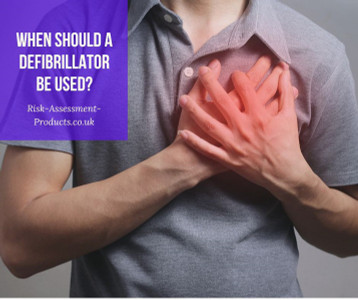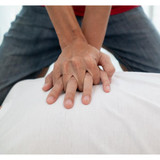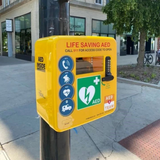When should a defibrillator be used?
A defibrillator should be used when someone is suffering a sudden cardiac arrest. These can happen to anyone, regardless of age, gender or ethnicity so it’s important to have a defibrillator nearby such as at your work, in the local community, in supermarkets and sports facilities.
What is a cardiac arrest?
A cardiac arrest occurs when there is an electrical problem with the heart causing it to stop beating properly. They can be caused by arrhythmias where the electrical impulses may happen too fast, too slowly or erratically. The symptoms of a cardiac arrest are immediate and drastic, they include; sudden collapse, no pulse, no breathing and loss of consciousness. Other symptoms prior to a cardiac arrest may include chest discomfort, shortness of breath, heart palpitations or weakness. If you are with someone who suffers a sudden cardiac arrest, you need to act fast.
What do defibrillators to?
When you need to use a defibrillator, there will be easy steps to follow to ensure you use it correctly. You must first call the emergency services, begin CPR and locate your nearest defibrillator. From here, the guide will demonstrate what you need to do. Once the electrode pads are place on the patients chest, the defibrillator will begin scanning the heart’s rhythm to determine whether a shock is needed.
If a shock is required and you have an automatic external defibrillator, it will administer the shock itself. If you have a semi-automatic defibrillator however, it will alert you to press a button which will then administer the shock. A shock from a defibrillator is designed to stop the heart so that it can begin beating again at it’s natural pace. A defibrillator will never shock someone if it is not required.
What steps should I follow?
If you are with someone who falls ill and is suffering from a cardiac arrest, you need to act fast. Call the emergency services straight away and begin CPR. Whilst you are doing this, you also need to find your nearest defibrillator.
Where to find your nearest defibrillator and how to use one
Defibrillators can be found in supermarkets, sports facilities, office buildings and in local towns and villages. If you can’t find one quickly enough nearby, visit the Defib Finder website here and enter your city or postcode to locate the closest defibrillator to you. Once you have the defibrillator, follow these steps to ensure you deliver the correct care, this includes:
- Turn on the defibrillator by pressing the green button and follow it’s instructions
- Peel away the sticky pads and attach to the patient’s skin - one to each side of the chest
- When the pads are attached, stop performing CPR and don’t touch the patient. The defibrillator will be checking the patients heart rhythm.
- The defibrillator will determine whether a shock is needed. If it is an automatic defibrillator it will do this itself, if semi-automatic it will require you to press a button to administer the shock
- The defibrillator will tell you that the shock has been given and whether or not you need to continue giving CPR.
- Continue with chest compressions until you see sign of life or, until the defibrillator tells you to stop so that it can analyse the heart’s rhythm again.
Most defibrillators come with audio and visual guides which will prompt you through the entire process until the emergency services arrive. For every minute that a defibrillator is not used, the chances of survival drastically reduce so it’s very important to act fast.
Recent Posts
-
What is CPR?
Knowing the basics of first aid and how to deliver CPR (cardiopulmonary resuscitation) can make the …17th Nov 2024 -
What is a sudden cardiac arrest (SCA)?
Sudden Cardiac Arrest (SCA) is a critical medical emergency where the heart abruptly ceases to funct …17th Nov 2024 -
Empowering Communities: The Lifesaving Impact of CPR on Restart a Heart Day
Every year, on and around October 16th, an important event takes place - Restart a Heart Day. This a …16th Oct 2023




